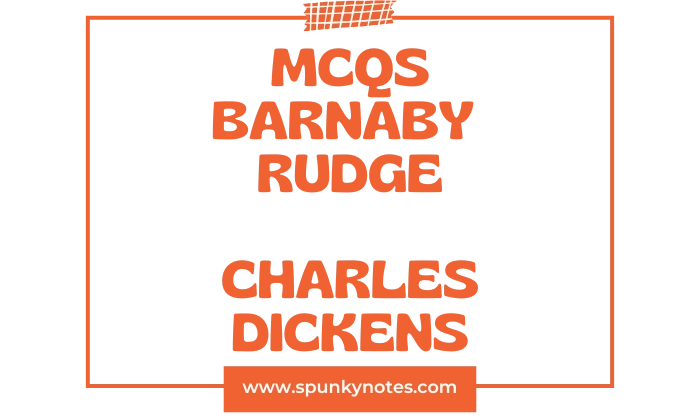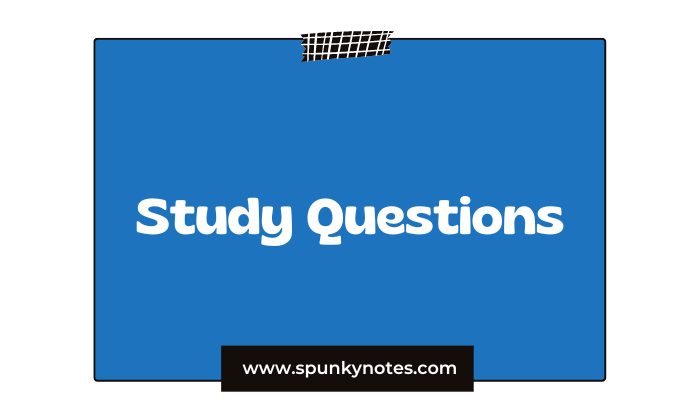
Barnaby Rudge MCQs
1. In what year did the events described in Chapter 1 take place?
A. 1776
B. 1775
C. 1780
D. 1770
2. What is the name of the house of public entertainment on the borders of Epping Forest?
A. The Royal Standard
B. The Golden Key
C. The Maypole
D. The Red Lion
3. Who is the landlord of the Maypole Inn?
A. Joe Willet
B. Solomon Daisy
C. John Willet
D. Long Parkes
4. Which crony of the Maypole was the parish-clerk?
A. Long Parkes
B. Tom Cobb
C. Solomon Daisy
D. Joe Willet
5. What did Solomon Daisy see when he was out that caused him to flee in terror?
A. The Maypole burning
B. The likeness of a murdered man
C. The assassin
D. A ghost
6. What was the large, old, red-brick mansion where Emma Haredale lived called?
A. Chigwell Hall
B. The Warren
C. Epping House
D. Carlisle House
7. What is the name of the locksmith?
A. Sim Tappertit
B. John Willet
C. Gabriel Varden
D. Reuben Rudge
8. What was the name of the locksmith’s daughter?
A. Emma
B. Miggs
C. Dolly
D. Martha
9. What book did Mrs. Varden rely on when she was at odds with her husband?
A. The Bible
B. The Protestant Manual
C. The Thunderer
D. The Pilgrim’s Progress
10. What food did Mrs. Varden demand when she claimed to be ill from agitation?
A. Strong mixed tea and toast
B. Beef and ham cut thin
C. A and B
D. Nothing but water
11. Who was the gentleman who used flattery and maxims delivered in a “charming voice”?
A. Joe Willet
B. Gabriel Varden
C. Mr. Chester
D. Hugh
12. Sir John told Mrs. Varden that Edward was bound by duty and honour to do what?
A. Marry someone else
B. Join the army
C. Return to the Maypole
D. Apologise to her
13. Where did the ‘Prentice Knights secretly hold their meetings?
A. A dim, stuffy counting house
B. A cellar/vault below a tavern
C. The Golden Key attic
D. St. Dunstan’s Church
14. What did Simon Tappertit use as his symbol of authority as captain?
A. A broken sabre
B. A large key
C. A thigh-bone
D. A black flag
15. What task did Tappertit demand Gabriel Varden perform for the rioters at Newgate?
A. Write a letter
B. Pick the lock of the great door
C. Join the society
D. Forgive Sim
16. What injuries did Sim Tappertit suffer during the riots?
A. Gunshot wounds and crushed legs
B. Severe burns
C. Loss of an arm
D. A beating from Hugh
17. What did Sir John compare his relationship with Edward’s mother to?
A. A great passion
B. A simple exchange of objects
C. A financial transaction
D. A holy union
18. What kind of animal was Grip?
A. A parrot
B. A magpie
C. A raven
D. A dog
19. What mark did Barnaby clasp when he felt a physical manifestation of fear about the murder?
A. The sign of a cross
B. The mark upon his wrist
C. His mother’s hand
D. His throat
20. What had the widow been an example of, according to Mr Haredale?
A. Piety and devotion
B. Patience and fortitude
C. Wealth and honour
D. Silence and respect
21. What did the man in the hackney-coach give Barnaby?
A. Money
B. A blue cockade
C. A letter
D. A horse
22. Barnaby was sentenced to death for being involved in what riotous activity?
A. Destroying chapels
B. Attacking the Maypole
C. Breaking into Newgate
D. Leading the crowd
23. Barnaby was ultimately spared his fate due to whom?
A. Lord George Gordon
B. The locksmith and Mr Haredale
C. His mother
D. The hangman
24. Who did Hugh (the centaur) receive his orders and advice from?
A. Geoffrey Haredale
B. Lord George Gordon
C. Sir John Chester
D. John Willet
25. What was the profession of the man who joined Hugh and Tappertit in the riots?
A. A footpad
B. An executioner (hangman)
C. A bailiff
D. A farrier
26. What did Dennis admire about Hugh, wishing he could apply his “professional emoluments” to it?
A. His strong arms
B. His throat/neck
C. His fighting spirit
D. His hatred of Papists
27. Hugh’s final speech, before his own death, expressed faith that which life would be spared?
A. His own
B. Dennis’s
C. Barnaby’s
D. Rudge’s
28. What was the fate of Dennis the hangman?
A. He escaped
B. He was pardoned
C. He was hanged
D. He was transported
29. What colour distinguished the cockades worn by the Protestant Association?
A. Black
B. Red
C. Blue
D. White
30. Who was the secretary to Lord George Gordon?
A. John Grueby
B. Mr. Haredale
C. Mr. Gashford
D. Sir John Chester
31. What did Rudge’s wife say the crime (murder) had put its curse on?
A. The money
B. Their son, before his birth
C. Her father
D. Her religion
32. Who was revealed to be Rudge, the murderer, living in Newgate?
A. The blind man
B. Barnaby’s father
C. Sir John Chester
D. The turnkey
33. Who was the most astonished person when Dolly was kidnapped?
A. Simon Tappertit
B. Emma Haredale
C. Poor little Dolly
D. Hugh
34. What was Joe Willet’s injury sustained in the wars?
A. He lost his arm
B. He lost his leg
C. He lost his eyesight
D. He lost his hearing
35. Who did Edward Chester marry?
A. Dolly Varden
B. Miss Miggs
C. Emma Haredale
D. Miss Wackles
36. What did John Willet say about the Maypole’s clock after the riots?
A. It was faster than ever.
B. It was “full two minutes” slow.
C. It had stopped completely.
D. It was the only thing that survived.
37. What was the fate of Sir John Chester?
A. He was killed in a duel by Mr. Haredale.
B. He became a respected politician.
C. He died in poverty.
D. He was imprisoned for his role in the riots.
38. What happened to Mr. Haredale after the duel?
A. He was celebrated as a hero.
B. He retired to a monastery in Italy.
C. He married Mrs. Rudge.
D. He became the new landlord of the Maypole.
39. What happened to Lord George Gordon?
A. He was executed for treason.
B. He fled the country.
C. He was acquitted of high treason but later died in Newgate.
D. He became a celebrated Protestant hero.
40. What was the final fate of Sim Tappertit?
A. He became a great political leader.
B. He was executed with Hugh.
C. He became a shoeblack, married a shrew, and lost his legs.
D. He married Dolly Varden.
41. What happened to Miss Miggs?
A. She married Sim Tappertit.
B. She became a jailer at a female prison.
C. She married Joe Willet.
D. She became Mrs. Varden’s loyal companion.
42. Who became the landlord of the rebuilt Maypole Inn?
A. John Willet
B. Joe Willet
C. Solomon Daisy
D. Gabriel Varden
43. What happened to Grip the raven?
A. He was killed in the riots.
B. He died peacefully of old age.
C. He flew away and was never seen again.
D. He was stuffed and preserved after death.
44. What was the central historical event depicted in the novel?
A. The French Revolution
B. The American Revolution
C. The Gordon Riots
D. The Jacobite Rising
45. What was the secret ambition of Simon Tappertit?
A. To marry Dolly Varden
B. To become the King’s locksmith
C. To crush the nobility and become a dictator
D. To earn Gabriel Varden’s respect
46. Who was the mysterious stranger who visited the Maypole 22 years ago?
A. Mr. Haredale
B. Sir John Chester
C. Rudge, Barnaby’s father
D. A highwayman
47. What did the rioters burn that belonged to Mr. Haredale?
A. His stables
B. The Maypole Inn
C. His house, The Warren
D. His crops
48. What was the name of the hangman?
A. Hugh
B. Sim Tappertit
C. Ned Dennis
D. Gashford
49. What did Sir John Chester have in his snuff-box?
A. Tobacco
B. A hidden miniature
C. A set of false teeth
D. Poison
50. Who was revealed to be Sir John Chester’s illegitimate son?
A. Barnaby Rudge
B. Hugh
C. Sim Tappertit
D. Joe Willet
Brief Overview
Barnaby Rudge is a historical novel by Charles Dickens. It is set during the real-life Gordon Riots, which were violent anti-Catholic protests in London in 1780.
The story follows two main plots. The first is a mystery about an unsolved murder 22 years before the novel begins. The second follows the title character, Barnaby Rudge.
Barnaby is a simple, good-natured young man who is easily influenced. He lives with his caring mother and his clever talking raven, Grip. Barnaby gets swept up in the chaos of the riots, believing he is doing something important.
Other characters include the stubborn innkeeper John Willet, his son Joe, and Joe’s beloved, Dolly Varden. As the riots grow, the mob burns Newgate Prison and attacks the homes of Catholics, including the Haredale family.
The novel’s climax connects the two plots. The rioters are stopped, and the old murder mystery is finally solved, revealing a shocking connection to Barnaby’s own family.

